1902: "The Queen Victoria Jubilee Monument and the Hongkong Club"
Primary tabs
Where: It's the view across Statue Square [1], with Queen Victoria's statue [2] in the foreground, and the Hongkong Club [3] beyond.
Between the two we can see an untidy patch of land. It would get worse before it got better, as by 1909 the area had acquired a brick oven, two simmering cauldrons of coal tar, and ...
"an unsightly conglomeration of ramshackle and tattered matsheds, piles of rotting poles, odds and ends of old timbers, untidy heaps of granite chippings, weed-grown stacks of bricks; cook-houses— other outhouses —all the stagnant squalor which collects in a builder’s yard. [4]"
By then the end was in sight, and once the nearby building projects were completed, the area was finally grassed over.
After the First World War, it was chosen as the ideal site for the new war memorial, and Hong Kong's Cenotaph [5] was erected there:
| Digital copies of Gwulo's photos are available to license for your books, brochures, and other media projects. |
When: The photo was taken in 1902 by R C Hurley [6] for his book, Views of Hong Kong.
What: The oldest of the temporary buildings [7] is over on the left, originally built as the office for the Praya Reclamation.
On the right of the building site there's a steam-powered crane on a short length of railway track.
Was the steam engine also connected to the wheels, or did it just power the lifting so that the crane had to be moved by muscle-power?
There's another short length of railway track over on the seafront. It would make sense for the two railway lines to be connected, so the crane could be used to unload building materials from boats at the harbour wall. Unfortunately the low building is in the way, so we can't see if that was the case.
There's another steam crane out in the harbour.
I believe that is working on the project to extend the Naval Dockyard, either dredging, or lowering stone blocks into position to build the new sea wall.
Beyond that, the white ship is HMS Tamar.
When the dockyard extension is finished, Tamar will move into its new home there. It will be moored along the west side of the dockyard's new tidal basin.
Who: A couple of rickshaw pullers are outside the entrance to the Club, waiting for customers.
What else can you see in this photo?
Gwulo image ID: NDA07
References:
- Statue Square
- Queen Victoria's statue
- The Hongkong Club
- Minutes of the Legislative Council Meeting for 2nd December, 1909
- The Hong Kong Cenotaph
- R C Hurley
- Temporary buildings in Statue Square
|
New on Gwulo.com this week:
Readers ask for information (photos, facts, memories, etc.) about:
|
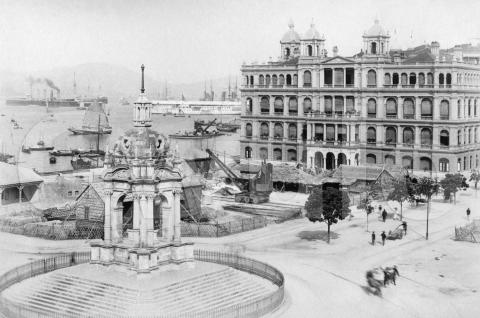
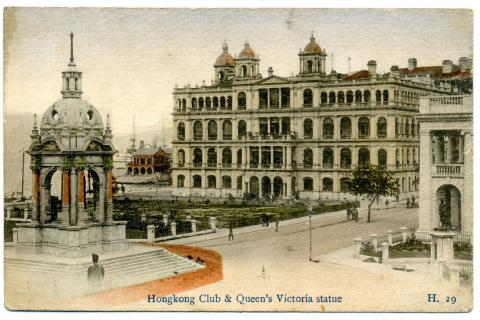
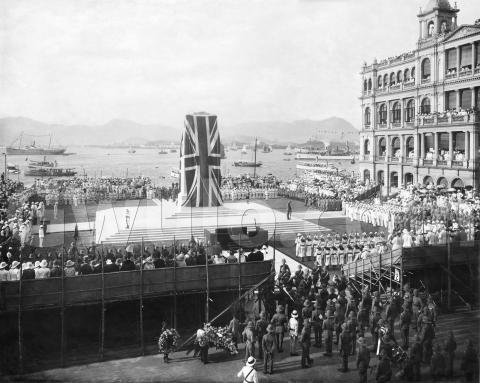
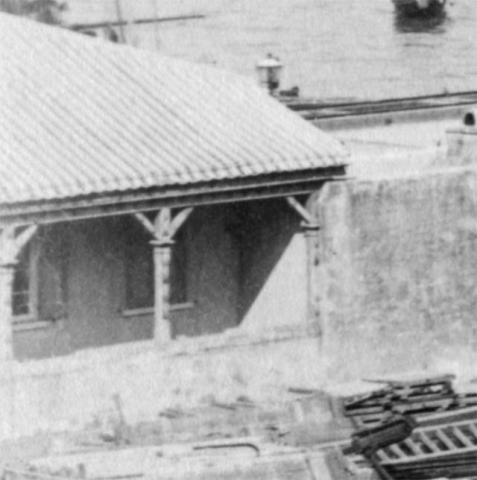
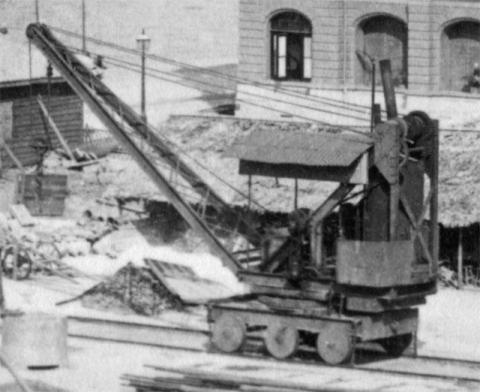
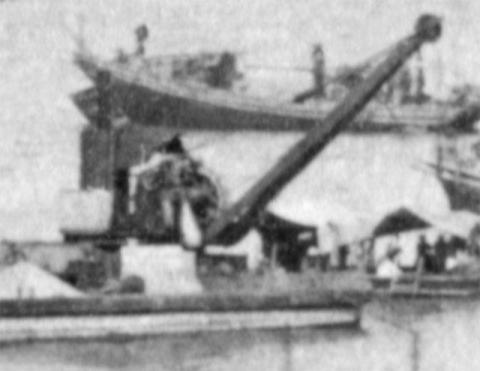
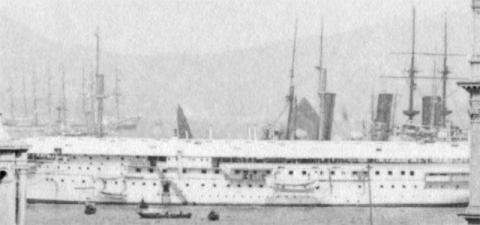
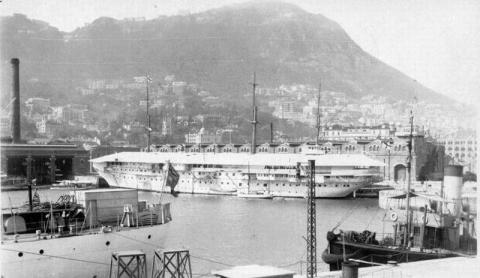
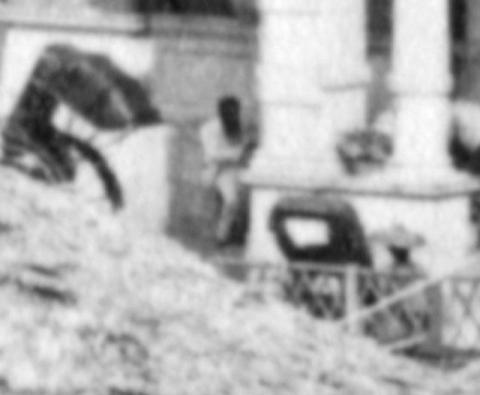

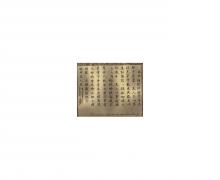
Comments
Tree treatment
Nothing much gwulo about what I see, but the trees seem strange. Was the road a paved one, as it appears so here, and should logically be so? If it was, then I see none of the buttresses or roots. Did people just pave right over the roots so that only the small circumference of the young tree trunk would extrude? What happened when they grew larger?
It rather looks like the treatment that some trees in busy pavements got in Hong Kong nowadays.
breskvar
Steam crane
Steam cranes which I have seen have been self-propelled using a gear mechanism underneath the frame. Taking into account the size and weight of the crane and the need to for it to move about on the site, it's doubtful that it was pushed by workers.
two of the ships in the pic
Top left at the back you can see two RN four-funnelled cruisers. The nearest I suspect is HMS Argonaut and the one to the east of her HMS Cressy. Both were on station in 1902 and a careful trawl of the daily newspaper (no time just now) would reveal what days they were both in port at the same time. This would have been a fairly rare event, so at a guess would pin Hurley's image down to a few days.
Stephen D
Steam Crane - Self Propelled ?
I agree that most rail-mounted steam cranes were self-propelled but not all. If they were small and pottering around on short lengths of track in goods yards etc. they could be moved around by shunting locomotives or simply man-handled into position by a few strong men.
I personally have doubts that the crane in this picture was self-propelled because I am unable to see any drive or gearing mechanism on the forward or rear axles. The centre axle is not visible but this was unlikely to be a powered axle because the crane's turntable located immediately above it would prohibit any protruding cog wheels or other gearing.
This picture (click link) shows a self-propelled crane of roughly similar size but the drive gear (cog wheel) is clearly visible on the rear axle.
Trees, Cranes and Ships
Thanks for the extra information about the cranes and ships. I'll keep an eye out when reading through the PWD's Annual Reports, and they might tell us more about the cranes that were used.
Interesting question about the trees. If the roads weren't tarred then, perhaps they let enough water into the ground to keep the trees going? But that's a guess! Does anyone have a better answer?
Regards, David
Trees, Cranes and Ships
Greetings. I think this is not an ideal place for growing trees unless they can tolerate sea water which may seep in. There might be a open storm sewer nearly providing fairly dependable water especially if it drains a large area . Besides water, a tree needs nutrients or fertilizers so when the food supply from the root region runs out, further growth is limited. We had a grape plant on our level 3 walk out planted with new soil. It gave bumper crops the first two years but after that, only leaves and very few and small grapes. Regards, Peter